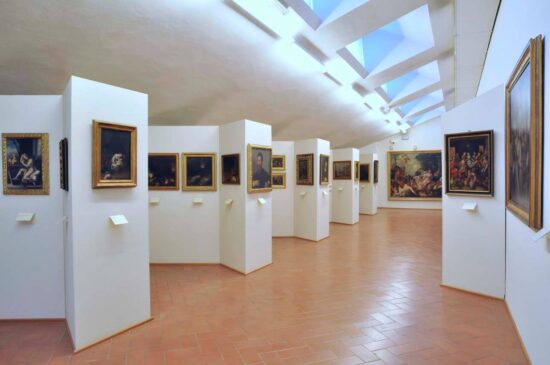Pinacoteca Nazionale di Siena
To find the Pinacoteca Nazionale di Siena, you follow Via S. Pietro, a road full of restaurants, trattorie (less formal restaurants), and osterie (place serving wine and simple food), you will soon reach the number 29. In Via San Pietro, 29, nestled inside two adjacent palazzi, the Palazzo Buonsignori a late-Gothic palazzo built in 1440 for a Sienese banker, and Palazzo Brigidi, a typical Sienese Palazzo of the 14th century, lies the Pinacoteca Nazionale di Siena.
The history of the gallery begins in the 18th century, during an era of Enlightenment characterized by the search and recovery of paintings which in the Middle Ages had adorned cathedrals, churches, and Gothic monasteries. Paintings that were regaining the attention of intellectuals.
Among them is abbot Giuseppe Ciaccheri, a librarian of the University and passionate collector of objects of the past, especially of panel paintings of the fourteenth century which were brought together as the heart of the museum’s works, (about a hundred of them). They were joined, in the nineteenth century, by other important collections, following the suppression of the lay brotherhoods (1785), the Napoleonic convents (1810), and the acquisition of the paintings of the Hospital of Santa Maria della Scala.


Housed in the fifteenth-century palazzo on Via San Pietro, donated by owner Nicholas Bonsignori, the collection covers three floors and its most prominent possessions include the masterpieces by Duccio, Simone Martini, the brothers Pietro and Ambrogio Lorenzetti, and the late-Trecento artists who worked in Siena after the terrible black Death of 1348: Luca di Tommè, Bartolo di Fredi, Andrea, and Taddeo di Bartolo, Angelo Puccinelli. It then sprawls further to the works of the fifteenth century by Giovanni di Paolo, and Sano di Pietro; and then the boards painted by Sassetta, Domenico di Bartolo, Matteo di Giovanni, Oldie, Francesco di Giorgio, Neroccio di Bartolomeo Landi.
On the first floor Domenico Beccafumi along with his followers, from Marco Pino to Brescianino; and an entire room devoted to the painters who, after the end of the sixteenth century, first worked in the late Mannerist style, as Alessandro Casolani, Francesco Vanni, Ventura Salimbeni, and then in the naturalist style, influenced by the novelty of Caravaggio: Rutilio Manetti and Bernardino Mei.


On the third floor the paintings of the Piccolomini collection that the family donated to the city in 1835, with significant exponents of Nordic art, Flemish, German, Venetian, and Lombard, mainly coming from the collections of the Gonzaga di Mantua and outstanding works by Albrecht Dürer ( Self-Portrait ), by Lorenzo Lotto ( Nativity ) and Bernardino Campi. Also important is the restoration in the museum of one of the most picturesque areas of the building, the so-called loggia, marked by the presence of large windows overlooking the panorama of the rooftops of Siena and the countryside just outside the city walls. Description by www.coopfirenze.it



